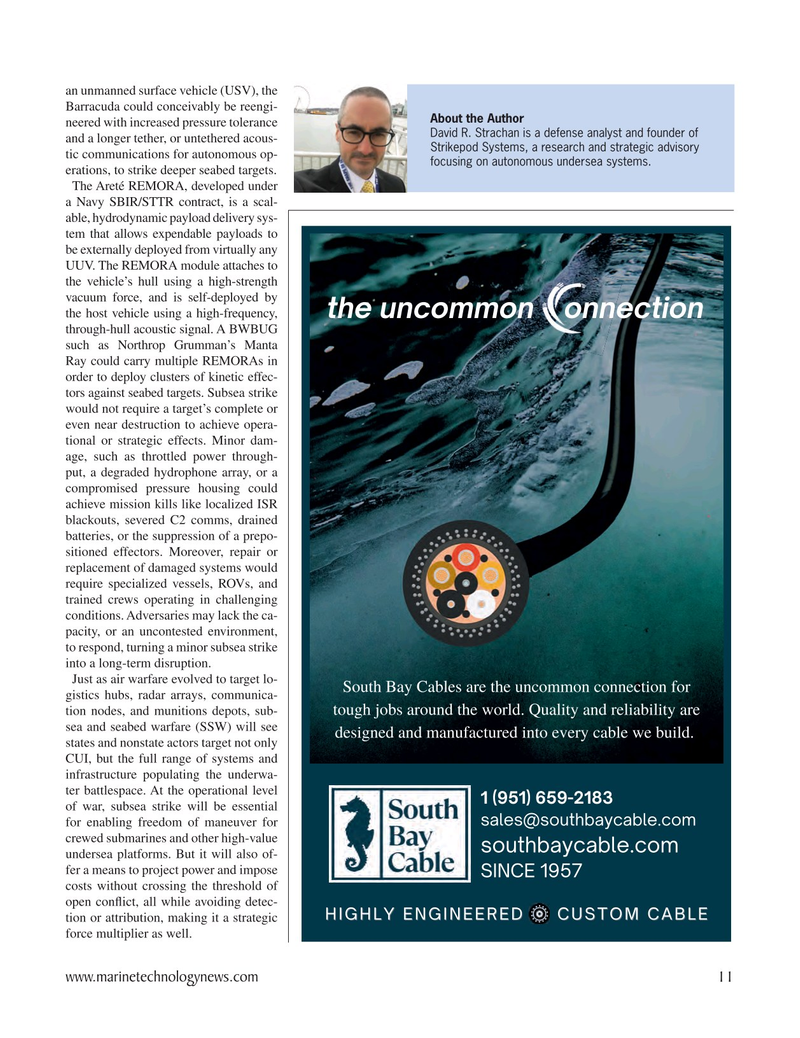
Page 11: of Marine Technology Magazine (May 2025)
Read this page in Pdf, Flash or Html5 edition of May 2025 Marine Technology Magazine
an unmanned surface vehicle (USV), the
Barracuda could conceivably be reengi-
About the Author neered with increased pressure tolerance
David R. Strachan is a defense analyst and founder of and a longer tether, or untethered acous-
Strikepod Systems, a research and strategic advisory tic communications for autonomous op- focusing on autonomous undersea systems.
erations, to strike deeper seabed targets.
The Areté REMORA, developed under a Navy SBIR/STTR contract, is a scal- able, hydrodynamic payload delivery sys- tem that allows expendable payloads to be externally deployed from virtually any
UUV. The REMORA module attaches to the vehicle’s hull using a high-strength vacuum force, and is self-deployed by the host vehicle using a high-frequency,
Ç??˪¯©©¯ª¯ªª?Ç?¯ª through-hull acoustic signal. A BWBUG such as Northrop Grumman’s Manta
Ray could carry multiple REMORAs in order to deploy clusters of kinetic effec- tors against seabed targets. Subsea strike would not require a target’s complete or even near destruction to achieve opera- tional or strategic effects. Minor dam- age, such as throttled power through- put, a degraded hydrophone array, or a compromised pressure housing could achieve mission kills like localized ISR blackouts, severed C2 comms, drained batteries, or the suppression of a prepo- sitioned effectors. Moreover, repair or replacement of damaged systems would require specialized vessels, ROVs, and trained crews operating in challenging conditions. Adversaries may lack the ca- pacity, or an uncontested environment, to respond, turning a minor subsea strike into a long-term disruption.
Just as air warfare evolved to target lo- 6RXWK%D\&DEOHVDUHWKHXQFRPPRQFRQQHFWLRQIRU gistics hubs, radar arrays, communica-
WRXJKMREVDURXQGWKHZRUOG4XDOLW\DQGUHOLDELOLW\DUH tion nodes, and munitions depots, sub- sea and seabed warfare (SSW) will see
GHVLJQHGDQGPDQXIDFWXUHGLQWRHYHU\FDEOHZHEXLOG states and nonstate actors target not only
CUI, but the full range of systems and infrastructure populating the underwa- ter battlespace. At the operational level ìCôðìcñðôCíìóî of war, subsea strike will be essential
Ár¤?ÁJÁ¯ËÇ?~rÛr~¤?ö¯© for enabling freedom of maneuver for crewed submarines and other high-value
Á¯ËÇ?~rÛr~¤?ö¯© undersea platforms. But it will also of- fer a means to project power and impose
O'8ìôðò costs without crossing the threshold of open con

 10
10

 12
12
